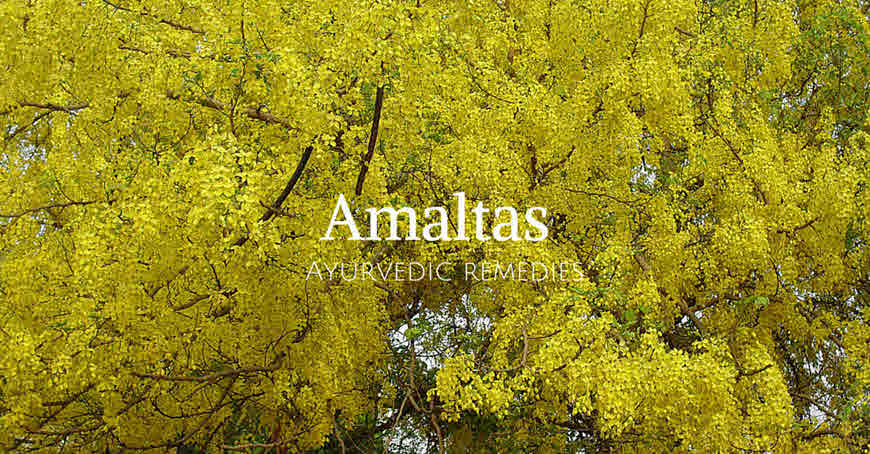Cassia fistula is grown as ornamental tree and is easily identifiable by its beautiful yellow flowers that grow on long pendulous racemes. This tree is native to India. It flowers during hot weather from April to May. After flowering fruits are developed in the form of cylindrical pods. These are initially green and later turn black. The tree propagates through mature seeds.

In India, Cassia can be seen growing along the roadsides, in parks and gardens. It is state flower of Kerala (India) and national tree of Thailand. Cassia fistula is used in traditional medicine system of Sri Lanka, Burma and India. In Ayurveda, this tree is used for treating constipation, fever, digestive troubles and skin diseases. Its fruit pulp along with some other herbs is cooked in water to prepare decoction which is used to treat fever and related complications.
Taxonomic Classification
- Kingdom – Plantae
- Subkingdom – Tracheobinota
- Super Division – Spermatophyta
- Division – Mangoliophyta
- Class – Magnoliopsida
- Sub Class – Rosidae
- Order – Fabales
- Family – Fabacae
- Genus – Cassia
- Species – fistula
Vernacular names
- Sanskrit: Kritamala, Vyadhighata, Shampaka, Shamyaka, Nrpadruma, Kritamalaka,
- Rajavriksha
- Bengali: Sondaalee, Sonaalu
- English: Indian Laburnum, Purging Fistula, Pudding pipe tree
- Gujrati: Garmaalo
- Hindi: Amaltaas, Girimaal
- Kannada: Kakke, Kakkemar
- Malayalam: Konna
- Marathi: Baahvaa
- Oriya: Sunaari
- Punjabi: Amaltaas, Kaniyaar, Girdnalee
- Tamil: Konnai
- Telugu: Rela
- Urdu: Amaltaas
English: Indian Laburnum, Purging Fistula, Pudding pipe tree, Golden shower, Golden pipe tree
Cassia fistula is medium sized deciduous tree, 6 to 9 m tall with bright yellow flowers in long pendulous racemes, and long cylindrical blackish-brown pods of 25 to 50 cm in length and up to 3 cm in width;found wild and also commonly planted as ornamental tree in most parts of the country up to an altitude of 1200 m.
Ayurvedic Properties and Action of Bark on body
- Rasa (Taste): Tikta/Bitter
- Guna (Characteristics): Guru/Heavy
- Virya (Potency): Cold
- Vipaka (Post Digestive Effect): Katu/Pungent
- Effects on Tridoshas (Humor): Pacifies Vata and Pitta
Medicinal uses of Purging Cassia
Cassia fistula has the liver protecting, inflammation reducing, cough suppressing, wound healing, anti-microbial and constipation curing properties.
Scientific studies confirms the liver protecting properties of leaves. One such study done on rats with paracetamol induced hepatotoxicity, the leaves exhibited significant the liver protective effect by lowering the serum levels of transaminases (SGOT and SGPT), bilirubin and alkaline phosphatase (ALP). Studies also confirms the anti-inflammatory and antioxidant activities of Cassia fistula and thus supports the traditional use of this tree in the treatment of rheumatism, gout, etc.
For the medicinal purpose, all parts of the tree viz. roots, bark, leaves, fruits are used. The fruit pulp is a medicine for curing constipation. The fruit pulp is consumed in the evening after meals in a dose of 5-10 grams to get relief from intestinal worms and constipation. This also gives relief in indigestion, abdominal gas and strengthens intestine. The leaves are also laxative. For curing constipation, tender leaves are cooked and eaten as leafy vegetables. The leaves are rubbed on skin in case of severe itching. The decoction is given to treat fever, inflammation and bacterial infections.
Distension of abdomen due to obstruction to passage of urine and stool
Eating 5 grams fruit pulp with sugar and water once a day is helpful.
Skin eruptions, ring worms, eczema, irritation
Prepare paste of leaves and bark. Apply at affected areas.
Abdominal pain due to gas
Prepare paste of fruits pulp and apply around naval.
Detoxifying gastrointestinal tract (kostha)
For removing toxins from gastrointestinal tract extract pulp of cassia pod. Take 5-10 grams of this pulp with hot milk.
Rheumatism
Traditional remedy is to roast 12-24 grams leaves of cassia fistula in mustard oil and take twice a day.
Gout (Vata rakta)
In gout, the roots (5-10g) are boiled in a glass of milk and taken twice a day for a few days.
Skin diseases
In skin diseases, cassia fistula leaves paste is applied externally.
Visarpa
In Ayurveda, erysipelas is known as visarpa. It is a skin condition in which large raised patches appear on skin. This is recurrent bacterial infection. A traditional remedy using Amaltas is, to prepare a leaves paste and mix that with ghee. This mixture is applied topically at affceted body part.
Constipation
For constipation, the fruit pulp 10-15 grams is soaked in half liter water at night. Next morning the pulp is mashed. This is filtered and filtrate is taken orally to get relief from constipation.
Chronic cough
For cough 12-24 grams ghee is prepared from the decoction of fruit pulp and taken twice a day.
Amaltas decoction using Cassia for fever
Ingredients:
Amaltas Cassia fistula, Kutki Picrorhiza Kurroa, Nagarmotha Cyperus scariosus, Baheda Terminalia bellirica
Process to make
- Take fresh Amaltas pod and break it open. Take out pulp from it.
- Add the pulp (10 gm), Kutki (1 gm), Nagarmotha (2 gm) and Baheda (2 gm) in water (400 ml).
- Cook till water reduces to 100 ml.
- Filter the decoction.
Drink this decoction few times a day, for a few days.
This decoction helps in following
- Cure fever
- Improve the liver function
- Improve digestive function
- Cure weakness due to fever
- Improve digestive function
- Remove toxins from the body
Useful information..